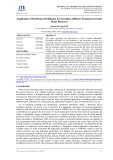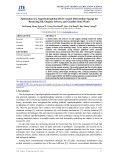
ISSN: 2615-9740
JOURNAL OF TECHNICAL EDUCATION SCIENCE
Ho Chi Minh City University of Technology and Education
Website: https://jte.edu.vn
Email: jte@hcmute.edu.vn
JTE, Volume 19, Special Issue 05, 2024
12
Hydrothermal Synthesis of Fenton Catalyst from Soybean Curd Residue Biochar
for Tetracycline Degradation
Quang Sang Huynh1, Quyen Kim Thi Doan2, Nguyen Duy Dat3*
1Phuc Thien Long Services Trading Joint Stock Company, Ho Chi Minh City, Vietnam
2Ton Duc Thang University, Vietnam
3Ho Chi Minh City University of Technology and Education, Vietnam
*Corresponding author. Email: datnd@hcmute.edu.vn
ARTICLE INFO
ABSTRACT
Received:
03/05/2024
In this study, heterogeneous catalysts were synthesized by hydrothermal
method to load nano goethite to biochar derived from soybean curd residue,
which served as catalysts for the heterogeneous degradation of tetracycline
hydrochloride (TCH) in an aqueous solution. The catalytic tests using this
composite material demonstrated significant TCH degradation. After 90
min of reaction, the optimum degradation of TCH in the aqueous solution
was achieved. The initial pH value and TCH concentration were set at 2
and 50 mg/L, respectively, and the ambient conditions were maintained.
The results showed that 0.5 g/L of catalyst and 60.0 mM H2O2 were the
ideal catalyst and reagent dosages. Experimental data showed that the
second-order kinetic model accurately described the degradation process
than the first-order kinetic model. The study showed that biochar-loading
goethite could be prepared from soybean crud residue and used for the
degradation of TCH in an aqueous solution. Additionally, these results also
provide a new approach for catalyst generation by the hydrothermal
method that might help reduce costs and be environmentally friendly.
Revised:
05/06/2024
Accepted:
11/06/2024
Published:
28/12/2024
KEYWORDS
Fenton;
Hydrothermal method;
Pharmaceutical;
Food waste;
Goethite.
Doi: https://doi.org/10.54644/jte.2024.1588
Copyright © JTE. This is an open access article distributed under the terms and conditions of the Creative Commons Attribution-NonCommercial 4.0
International License which permits unrestricted use, distribution, and reproduction in any medium for non-commercial purpose, provided the original work is
properly cited.
1. Introduction
Nowadays, one of the most common antibiotics, tetracycline hydrochloride (TCH), represents a
hazard to both humans and other living things when it leaks into the water source [1]. The increasing
demand for personal care and medicinal goods has an impact on the environment as well. It's interesting
to note that even in low quantities, leftover drugs and genes associated with antibiotic resistance can be
generated and diffused, leading to fetal harm or organ abnormalities [2]. Antibiotic residues and poor
biodegradability make traditional wastewater treatment techniques unsuitable for removing antibiotics
[3]. Consequently, it is imperative to look for a practical technique to remove organic antibiotic
contamination. Numerous techniques, including adsorption [4], oxidation [5], solvent extraction [6],
membrane separation [7], biodegradation [8], and others, have been used to remove TCH from
wastewater. These techniques, however, are typically vulnerable to intricate processes and potential
secondary contamination. One of the best ways to get rid of refractory organics is through the use of
advanced oxidation processes (AOPs), which produce reactive hydroxyl radicals (•OH). With its
discovery, the Fenton reaction received a lot of interest as one of the most sophisticated and effective
oxidation reactions.
The two types of Fenton reactions typically distinguished are homogenous and heterogeneous [9].
Fenton techniques are widely utilized because of their cost-effectiveness, ease of usage, and high •OH
production efficiency [10]. However, there are multiple limitations on the utilization of Fenton
processes. In other words, the homogeneous sort is not cost-effective and has particular problems with
ion recovery and separation following catalyst treatment [11]. Additionally, it has been noted that this
procedure may create metal hydroxide sludge and secondary pollutants like acid or metal ions [11]. The
application of the heterogeneous Fenton system can help solve the issues that were previously discussed.
The heterogeneous Fenton technology is a range of heterogeneous Fenton reagents, including Fe3O4

ISSN: 2615-9740
JOURNAL OF TECHNICAL EDUCATION SCIENCE
Ho Chi Minh City University of Technology and Education
Website: https://jte.edu.vn
Email: jte@hcmute.edu.vn
JTE, Volume 19, Special Issue 05, 2024
13
[12], Fe2O3 [13], FeOOH [14], and applying Fenton's catalyst to the surfaces of various carriers, such as
biochar, activated carbon, graphene, and so on [15].
It has been established that goethite works effectively as a heterogeneous Fenton-like catalyst to
degrade organic contaminants [16]. It can effectively activate H2O2 to generate hydroxyl radicals due to
the presence of Fe2+, magnetite which initiates the Fenton reaction. Notably, Goethite could participate
in the Fenton heterogeneous catalyst process; However, for Geothite-quantity saving purposes, the
loading of ion Fe on the surface could not only increase the catalyze efficiency but also save the amount
of Fe. Therefore, the selection of the catalytic surface plays an important role [17], [18]. There are a
variety of catalyze materials that require the cost-effectiveness, and they often use materials derived
from agricultural debris and, through thermolysis, produce biocarbon [19]. Previous studies have also
shown the use of biochar as a catalyst due to the attachment of iron ions to the biochar surface during
the decomposition of pollutants [20], [21]. The transformative methods of attaching iron ions to the
biochar surfaces of these studies usually use pyrolysis and impregnation. There are numerous
approaches to loading iron in the form of oxides on biochar support, including hydrothermal, co-
precipitation, and sol-gel processes [22].
The hydrothermal method is the most widely utilized since it is simple to perform and occurs at
relatively moderate temperatures [23]. One benefit of the non-extreme reaction temperatures is that the
hydrothermal process uses less energy. Simultaneously, it permits the use of low-cost, basic compounds.
Because the hydrothermal treatment is done at a low temperature, the reactions happen quickly [23].
Moreover, the hydrothermal approach provides benefits for the creation of a strong catalyst. This method
was chosen and utilized for modifying the precursor biochar created via pyrolysis of biomass sources
(soybean crud residue). Many biomass feedstock sources and adaptable preparation techniques allow
for the development of biochar with a range of uses and applications in the processes of water pollution,
mineralization, and degradation [24]. Furthermore, this food waste is typically recovered by pyrolysis,
which produces carbonaceous materials, in closed furnaces with or without very little oxygen present
[25]. By releasing greenhouse gases into the atmosphere, this has the benefit of reducing air pollution
[22].
This study used pyrolysis to create biochar from dried soybean crud residue [26]. The iron in the
previously - made biochar was then immobilized using the hydrothermal process. It also investigated
the way the particles worked under various pH and dose catalyst settings to aid in the Fenton oxidation
of TCH. The kinetics of the TCH degradation were also modeled using kinetic models that had
previously been published in the literature in order to determine the kinetic parameters related to the
catalysis or degradation processes involved.
2. Materials and Methods
2.1. Chemicals
Tetracycline hydrochloride was given by Sigma Aldrich. Deionized (DI) water was utilized to create
the solutions employed in this investigation, and all other reagents such as KOH, HCl, FeCl3.6H2O, and
ethanol 96o were analytical grade.
2.2. Preparation of catalyst materials
Figure 1. Materials synthesizing processes

ISSN: 2615-9740
JOURNAL OF TECHNICAL EDUCATION SCIENCE
Ho Chi Minh City University of Technology and Education
Website: https://jte.edu.vn
Email: jte@hcmute.edu.vn
JTE, Volume 19, Special Issue 05, 2024
14
Figure 1 highlights the materials synthesis techniques employed in this work. Soybean curd residue
from the tofu-making process was collected at traditional markets. First, it was dried at 105 oC for 24
hours and sieved to a size of less than 0.25 mm for storage; the dried soybean curd residue was then
referred to as SC. To make soybean curd biochar (BC), the sample was calcined in a furnace at 500 °C
for 2 hours, with a heating rate of 10 °C/min. The BC substance was then sealed in an airtight container
for further activation.
The Goethite (α-FeOOH) utilized in this investigation was produced using FeCl3. Firstly, a magnetic
stirrer was used to thoroughly mix KOH 5M and FeCl3.6H2O 1M for 10 min. Secondly, the freshly
created ferrihydrite may be able to age to goethite by drying at 70 °C for 24 hours. Subsequently, the
production was washed several times with ethanol (C2H5OH) and distilled water to adjust the final
solution pH to approximately 7. After being dried for 24 hours at 105 °C, the finished product was
ground to a size of 0.0105 μm [27].
To create the potential in the oxidation ability of the material, the BC sample was paired with α-
FeOOH to synthesize new materials for heterogenous oxidation process. BC is mixed with goethite in
different proportions, denoted with BCGx in a Teflon-lined autoclave, where x is the percentage of
goethite in the composite materials. The mixture was stirred at room temperature for 0.5 hours before
heating to 200 °C for 2 hours.
2.3. Analytical methods
Numerous operating parameters, such as pH and contact time, were used to perform the
heterogeneous Fenton process of TCH onto the composite material. Every experiment was conducted
with the starting H2O2 concentration and the solid/liquid (m/V) ratio held at 0.5 g/L. The substance was
added precisely 0.02 g to 40 mL of TCH-containing solution. The pH of solutions was adjusted both
before and during the Fenton process using NaOH and HCl (1M). After that, the mixture was stirred for
a predetermined amount of time at a regulated temperature at the speed of 250 rpm in an isothermal
shaker. A 0.45-μm filter paper was used to remove the loaded catalyst from the mixture after the
specified contact time. Additionally, the same procedures were followed in the preparation of the
controlled sample. Throughout the experiments, the laden solids were collected and dried for 24 hours
at 105 °C to examine the material's properties. Using a UV–vis spectrophotometer (Hitachi U-2910,
Hitachi Corp. Japan), the remaining medications in the solution were examined at the maximum
absorbance of 357 nm for TCH.
The surface morphology of materials and main surface elements was examined using scanning
electron microscope (SEM) images and the energy dispersive X-ray spectroscopy (EDS) data (JSM-
6510 LV), respectively.
3. Results and Discussion
3.1. Effect of the goethite proportions on the final composite materials
BCG0 BCG1 BCG2 BCG3 BCG5 BCG7 BCG9 BCG11
0
20
40
60
80
100 [TCH]o = 50 mg/L, 60 mM H2O2, 0.5 g/L, pH 2.
TCH removal (%)
Materials
Figure 2. Effect of the goethite proportions on the composite materials

ISSN: 2615-9740
JOURNAL OF TECHNICAL EDUCATION SCIENCE
Ho Chi Minh City University of Technology and Education
Website: https://jte.edu.vn
Email: jte@hcmute.edu.vn
JTE, Volume 19, Special Issue 05, 2024
15
Fig. 2 shows that, under the same reaction conditions, different amounts of iron will result in TCH
breakdown efficiency. The initial TCH concentration was 50 mg/L, pH 2, 0.5 g/L, 60 mM H2O2, and
room temperature. The results indicated that increasing iron content increased TCH removal efficiency.
The TCH removal efficiency was in the range of 12.8% to 58.2% when the iron content was changed
from 1% to 7%. The loaded iron content was higher than 7%, and the TCH removal efficiency was
significantly enhanced by more than 84%. However, adding too much iron (9%–11%) to the material
surface did not lead to a noticeable increase in treatment efficiency. The catalytic surface only attaches
Fe to the surface with a certain amount, so the increase in Fe content like BCG11 (11%) results in similar
data compared to BCG9 (9%) due to the release of iron in BCG11 through the material washing process.
Besides, the TCH removal of BCG0 was 8.5%, the BCG0 material probably is one in which non-
goethite loads onto the surface of the biochar. The performance mostly depends on the biochar's effective
adsorption capability after being denatured by a hydrothermal procedure. Additionally, Dat et al. have
observed that the rate constant of the Fe(III) and H2O2 reactions with a graphene catalyst is 100 times
higher than that of the process without a graphene catalyst [17].
3.2. Effects on the reaction parameters (pH, contacting time, and dosage catalyst) of TCH
030 60 90 120 150
0
20
40
60
80
100
TCH removal (%)
Time (min)
pH 2
pH 3
pH 4
pH 5
[TCH]0 = 50 mg/L, 60 mM H2O2, 0.5 g/L
Figure 3. Effect of the solution pH on the TCH degradation
The solution pH is one of the most crucial factors in chemical oxidation processes. This was studied
at pH values of 2, 3, 4, and 5 as this is a well-known factor that can remarkably affect the oxidation
reaction (Fig. 3). This parameter can influence the activity of the oxidant and the material. Fig. 3 shows
the influence of various pH ranges on TCH degradation in a Fenton reaction (BCG9/H2O2). As shown
in Fig. 3, the TCH removal efficiency decreased from 84.7% to 31.91% when the pH values increased
from 2 to 5 at 90 min. After 90 min, the TCH degradation was almost the same until 150 min.
The three acid dissociation constants of TCH (pKa value) were 3.3, 7.7, and 9.7, respectively. The
pH of the solution also affected the solubility rate of the iron components of the BCG catalyst [28].
Hence, the evaluation of the effect of pH in the initial solution varied from 2,0 to 5,0 for the removal of
TCH in this study, and the pH variation was recorded in the degradation procedure aimed at better
understanding the TCH degradation at different pH values. The decomposition of H2O2, the lower
oxidation potential of •OH radicals, and the catalyst's deactivation as a result of ferric hydroxide
complex formation are the reasons for the reduced degradation rate at higher pH values [28], [29]. On
the other hand, at pH 2,0, the high activity of Fe2+ can produce OH on the catalyst surface. As a result,
the highest degradation performance was observed at pH 2.0. At a pH of 4.0 to 5.0, the reaction of the
catalytic (Fe2+) and H2O2 can produce •OH radicals that are not strong enough to break down TCH,

ISSN: 2615-9740
JOURNAL OF TECHNICAL EDUCATION SCIENCE
Ho Chi Minh City University of Technology and Education
Website: https://jte.edu.vn
Email: jte@hcmute.edu.vn
JTE, Volume 19, Special Issue 05, 2024
16
resulting in a low rate of mutual elimination. According to the findings of our earlier investigation, pH
levels of about 2 are optimal for maximizing the generation of •OH during the Fenton oxidation process
[30]. The traditional Fenton process was shown in multiple earlier studies to have strong catalytic
activity in acidic environments with pH values between 2 and 4 [31].
030 60 90 120 150
0
20
40
60
80
100
[TCH]0 = 50 mg/L, 60 mM H2O2, pH 2
TCH removal (%)
Time (min)
0.1 g/L
0.25 g/L
0.5 g/L
0.75 g/L
1.0 g/L
Figure 4. Effect of dosage catalyst on the TCH degradation
The study assessed the impact of different BCG9 dosages (i.e., 0.1 to 1.0 g/L) on the TCH
degradation in the Fenton-like system. The initial TCH concentration was 50 mg/L, and the H2O2 dosage
was 60 mM at pH 2. The removal of TCH with BCG9 and H2O2 was demonstrated to be effective in
Fig. 4. According to the experimental data, the TCH removal efficiency tended to rise with increased
contact times. The maximum removal efficiency in the Fenton oxidation process with a reaction time of
150 min was 26.4% (0.1 g/L); 51.7% (0.25 g/L); 81.1 (0.5 g/L); 85.7 (0.75 g/L); and 88.9% (1.0 g/L).
The catalyst dose rose in proportion to the efficiency of TCH decomposition. The rate of degradation
increased as a result of the production of higher hydroxide radicals and more active sites when more
catalysts were applied [32]. The removal efficiency of TCH notably increased for a catalyst dose of 0.5
to 1.0 g/L. According to the research, a large dose of the catalyst may cause the coagulation reaction,
which decreases the concentration of hydroxide radicals and, as a result, reduces the removal
effectiveness of TCH [33], [34]. Furthermore, the increased removal effectiveness of TCH in this
situation may be due to boosting the degradation of H2O2 and raising the number of active sites, which
can produce more •OH radicals. Higher concentrations of heterogeneous catalysts offer more surface
area for the increased quantity of iron species needed to produce •OH radicals, and quenching of •OH
radials by excess iron ions in the reaction process (Equation 1) [17]. Additionally, a contact time of 90
min and a catalyst dosage of 0.5 g/L were identified as the optimal conditions for the Fenton oxidation
process utilizing a heterogeneous BCG9 catalyst.
Fe2+ + 2•OH => Fe3+ + 2OH-
(1)
3.3. Kinetic study of TCH degradation
The BCG9/H2O2 procedure of TCH degradation required numerous steps, and the dynamics of TCH
degradation were challenging. Based on prior research, the BCG9/H2O2 system's degradation kinetics
of TCH have been examined using two common kinetic mathematical models, the first-order and the
second-order models.
𝐶𝑡= 𝐶𝑜𝑒−𝑘1𝑡
(2)





![Bài giảng Xử lý nước thải công nghiệp ThS. Nguyễn Minh Kỳ [chuẩn nhất]](https://cdn.tailieu.vn/images/document/thumbnail/2019/20190814/tandlanh/135x160/860840055.jpg)
![Bài giảng Môi trường đô thị [mới nhất]](https://cdn.tailieu.vn/images/document/thumbnail/2015/20150929/mailai20796/135x160/9511443480091.jpg)
![Công nghệ màng MBR: [Thông tin chi tiết/Ứng dụng/Ưu điểm]](https://cdn.tailieu.vn/images/document/thumbnail/2013/20130403/hoangnhi2/135x160/6891364999568.jpg)









![Bài giảng Chế biến khoáng sản vô cơ [Mới nhất]](https://cdn.tailieu.vn/images/document/thumbnail/2025/20251025/thanhvan173002/135x160/21521761538638.jpg)








